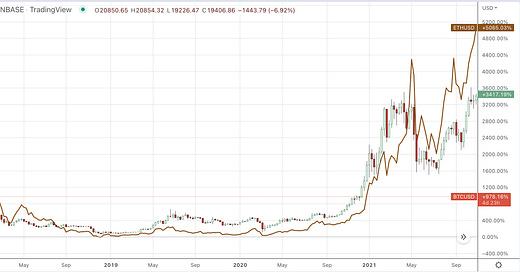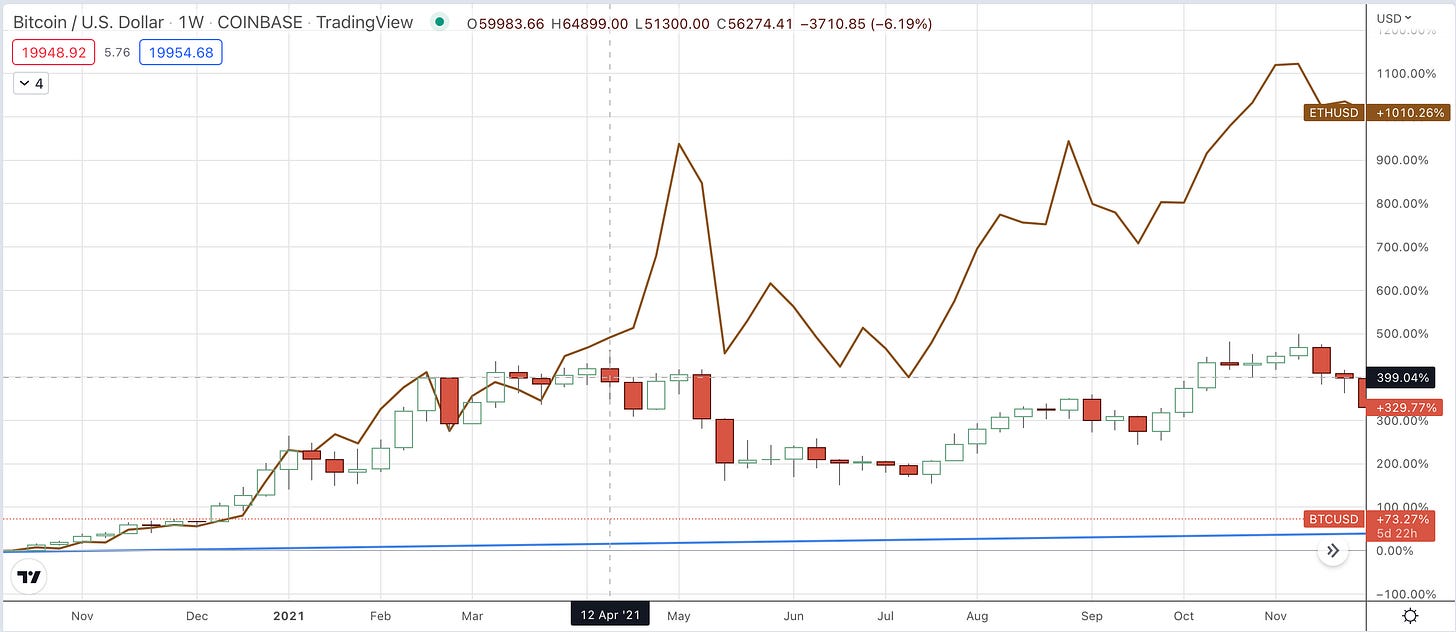In the last couple of months, as liquidity began to suck out of the crypto ecosystem and crypto lending vultures began crashing, the unwind brought out once again the loud calling for the death of Ethereum.
Admittedly, it felt odd reading Vitalik Buterin’s May Twitter thread on his contradictions. The post seemingly hinted at his readiness to throw in the towel, or at minimum, his need for an outlet to channel his inner Bitcoin Maximalism.

There could be truth to the idea Ethereum is dying but the cheering seems mostly driven by the stance that Bitcoin is money and ETH is not. While true, what’s more important, is that they aren’t even competing for the same goal. So, why does it matter?
Bitcoin is attempting to be better money. Money that acts as a store of value.
Ethereum’s angle is more, that of being technology around money.
If we think about it in terms of what we know and how things evolve based on new monetary technologies then maybe we could put the battle to rest? Look at the structure of the base traditional bank network which looks like Bitcoin. Look at the cross integration and connection credit card networks, ACH, etc add to the bank networks. It looks like Ethereum.
Is ETH’s Role To Define a Risk Curve Relative to Bitcoin?
Are we seeing the definition of a risk curve in crypto markets?
In traditional markets, gold is the most sound, bonds are slightly less sound, and equity after that. Yes, Bitcoin is working on some of these “cooler” things, but it’s the sound asset and Ethereum acts as the risk equities provide. Ethereum creates a risk curve. Where yield can be saught if desired.
In capital markets the further you move out on the curve, the risker it gets. The more yield you seek, the riskier it gets. As the masses flock to this new digital asset class, they’ve brought their gambling desires. Typically, the masses get bored of the knowns that Bitcoin and gold provide. They might be secure, but are “boring” and don’t scratch the itch of greed.
The same views and battles have been fought between equities and gold for over a few hundred years.
Sure, there could end up being just one protocol, one coin, one token. But not likely. What industry has just one player? TCP/IP, after all, is not ONE but TWO protocols. And how many competing protocols are built on top of the stack?
What Do The Charts Say?
I am a technician, I do believe in charts, and I do believe price action tells you everything you need to know before the news headlines.
The overarching goal is to decipher what the market is trying to tell you versus what story you are trying to tell the market. The market does what it wants to do, not what you want it to do. So it’s better to form an opinion based on price and relationships, rather than have an opinion that you’re trying to make price conform to.
What you see above is that during price spikes and into price tops, ETH outperforms BTC. Through the lense of risk, this makes sense. When markets get frothy the chase for risk blows out until it crashes, usually first. See QQQ or ARK Invest from late 2021 to now for example.
Looking closer at more recent periods, we can see this risk curve in motion again. From the breakout of Bitcoin in late 2020 (Oct) you can see it along with ETH traded in tandem. ETH was up about 900% and BTC up about 400%.
As Bitcoin began to slow, into April 2021, Ethereum (risk) began spiking higher. The kind of euphoric spike you see from risk into tops. Safer assets are left behind as gamblers go looking to satisfy their needs with little regard for the risk that’s being thrown around.
From the July 2021 bottom to the November 2021 top, much the same ETH (risk, +144%) outperformed BTC (saftey, +106%).
How Does ETH Look Relative to BTC Across Time?
Bitcoin was first to market and all other coins and tokens act as derivatives in some form or fashion.
You have Bitcoin. Add a little more risk to get Ethereum. Add even more risk and you get integrators and other layer One’s like LINK, Solana, Polkadot, and the likes. Add more risk, and you’re finally at pure risk which is Luna or any other algorithmic stablecoin, DeFi projects, ICO’s, or whatever new magic internet projects popup in the future.
And of course, you get facilitators like Celcius, Voyager, BlockFi, FTX, and a whole host of others. It’s Degen-ism at its finest. These tokens survive on ponzi-nomics and network effects that are short-lived, except in the minds of those soldiers in their Telegram channels. These tokens survive on the back of a risk curve. Risk curves are a natural part of markets.
The point is, the further you move away from Bitcoin, the more risk you take on.
With Wall Street’s invasion post 2018, could this be why you no longer find a non-correlation between Bitcoin and traditional markets? Has it, for all intents and purposes, adopted the same behaviors of traditional markets as larger pools of capital have flowed in?
Risk-Off Happens Fast
With the Luna collapse, Alts blew out quickly. Ethereum began unwinding shortly after and eventually, the carnage bled over to Bitcoin.
You see prices in the charts move first. Before the headlines.
High risk names crash. What’s left of that money flows back towards safety, one step at a time. Reversing back down the risk curve. If the situation worsens (like we saw) you see some Bitcoin money flow into stables or dollars as traders seek safety at all costs.
In markets, each asset class has a risk profile, and depending on where you are in the cycle different risk profiles take the lead.
Bitcoin and Ethereum Now
As you see, at the end of May ETH did decouple from Bitcoin.
One thing to notice is that it happened at the end of a descending wedge. While BTC came right to the lower side and reversed, Ethereum decoupled and gave the classic “overthrow”, or head fake. The reversal potential was stopped cold turkey with the onslaught of failing of exchanges and other yield entities, pulling BTC lower as we saw complete risk-off. Additionally, Wall Street piled on by using BTC has a hedge (short) against the QQQs.
Now, what’s left for both? To see if the lower side of the downtrend, the red dotted channel, holds. Keeping the Crypto Winter from getting even uglier.









